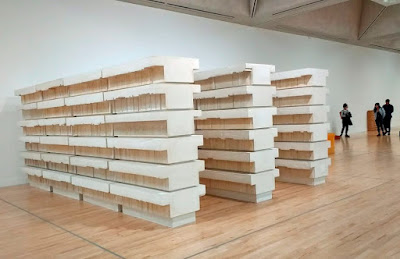29 October 2017
RACHEL WHITEREAD AT TATE BRITAIN
My preparation for Handmade in Britain is in on track, so I went to see the Rachel Whiteread retrospective at Tate Britain (above).
Whiteread has shown remarkable consistency over the thirty years since her Slade graduation, casting objects and the space around them to give us surprising views of the familiar world. Her high profile works, like House (1993) - the concrete cast of the inside of a house in east London - are familiar, but this exhibition introduced us to less familiar works, made in a series of major preoccupations during the course of her career. Her recent work comprises resin casts of doors and papier maché casts of fences and sheds walls. I particularly liked the assemblages of small objects on shelves made between 2005 and 2010 in materials of different colour, like Lineup (below), reminiscent proximately of Edmund de Waal and ultimately of Giorgio Morandi.
Whiteread began casting in papier maché and plaster and advanced to concrete, but she has cast in just about every possible material and has shown tremendous concentration and impressive craft. For the larger pieces she has drawn on specialist assistance, notably in House, which is described in a contemporary film of the construction process.
House was produced at the suggestion of James Lingwood of Artangel, which works with artists and funders to produce large creations outside galleries. "We knew the sculpture would generate interest from the beginning," Lingwood said, but "House was a lightning conductor". It divided opinion among both critics and the local population. Andrew Graham-Dixon called it "one of the most extraordinary and imaginative public sculptures created by an English artist this century", Brian Sewell described it as "meritless gigantism".
The film of house featured the fabricators who are essential to much contemporary art. Glen Adamson has said that the contribution of fabricators is not just overlooked but hidden because it is so important that it may reduce the reputation of the artist. Their role is different from that of bronze casters in traditional sculpture because traditional sculptors made their own models, and the relation of fabricators to artists is more like the relation of builder to architect. If you look carefully at the film of House, you will see that the construction was by Tarmac.
Subscribe to:
Post Comments
(
Atom
)




No comments :
Post a Comment